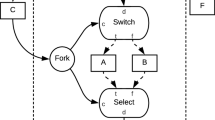Abstract
In this paper, novel objectives for the design space exploration of GPGPU applications are presented. The design space exploration takes the combination of energy efficiency and realtime requirements into account. This is completely different to the commonest high performance computing objective, which is to accelerate an application as much as possible.
As a proof-of-concept, a GPGPU based image processing and virus detection pipeline for a newly developed biosensor, called PAMONO, is presented. The importance of realtime capable and portable biosensors increases according to rising number of worldwide spreading virus infections. The local availability of biosensors at e.g. airports to detect viruses in-situ demand to take costs and energy for the development of GPGPU-based biosensors into account. The consideration of the energy is especially important with respect to green computing.
The results of the conducted design space exploration show that during the design process of a GPGPU-based application the platform must also be evaluated to get the most energy-aware solution. In particular, it was shown that increasing numbers of parallel running cores need not decrease the energy consumption.
Similar content being viewed by others
References
Amdahl G (1967) Validity of the single processor approach to achieving large scale computing capabilities. In: Proceedings of the 1967 spring joint computer conference (AFIPS), pp 483–485
Benini L, Lombardi M, Milano M, Ruggiero M (2008) A constraint programming approach for allocation and scheduling on the cell broadband engine. In: Stuckey PJ (ed) CP. Lecture notes in computer science, vol 5202. Springer, Berlin, pp 21–35
Bui P, Brockman J (2009) Performance analysis of accelerated image registration using GPGPU. In: Proceedings of 2nd workshop on general purpose processing on graphics processing units, GPGPU-2. ACM, New York, pp 38–45
Cho S, Melhem R (2008) Corollaries to Amdahl’s law for energy. IEEE Comput Archit Lett 7(1):25–28
IBM corporation: (2010) Product description of the IBM CELL broadband engine. http://www.ibm.com/developerworks/power/cell/
Keinert J, Streubühr M, Schlichter T, Falk J, Gladigau J, Haubelt C, Teich J, Meredith M (2009) SystemCoDesigner: an automatic ESL synthesis approach by design space exploration and behavioral synthesis for streaming applications. ACM Trans Des Autom Electron Syst 14:1–23
Khronos Group: (2010) OpenCL specification. http://www.khronos.org/registry/cl/
Nere A, Lipasti M (2010) Cortical architectures on a GPGPU. In: Proceedings of the 3rd workshop on general-purpose computation on graphics processing units
Nikolov H, Thompson M, Stefanov T, Pimentel A, Polstra S, Bose R, Zissulescu C, Deprettere E (2008) Daedalus: toward composable multimedia mp-soc design
NVIDIA: (2011) NVIDIA geforce. http://www.nvidia.com/
Pulli K (2009) OpenCL in handheld devices. In: 4th annual multicore EXPO
Ren D, Suda R (2009) Power efficient large matrices multiplication by load scheduling on multi-core and GPU platform with CUDA. In: Proceedings of the 2009 IEEE international conference on computational science and engineering, vol 1, pp 424–429
Rofouei M, Stathopoulos T, Ryffel S, Kaiser W, Sarrafzadeh M (2008) Energy-aware high performance computing with graphic processing units. In: Proceedings of the 2008 workshop on power aware computing and systems (HotPower)
Timm C et al. (2010) Energy considerations within the integration of general purpose GPUs in embedded systems. In: Proc of the annual int conf on advances in distributed and parallel computing (ADPC)
Weichert F, Gaspar M, Timm C, Zybin A, Gurevich E, Engel M, Müller H, Marwedel P (2010) Signal analysis and classification for surface plasmon assisted microscopy of nanoobjects. Sens Actuators B, Chem 151:281–290
Weichert F, Timm C, Gaspar M, Zybin A, Gurevich EL, Müller H, Marwedel P (2011) GPGPU-basierte Echtzeitdetektion von Nanoobjekten mittels Plasmonenunterstützter Mikroskopie. Bildverarbeitung für die Medizin. Springer, Berlin, pp 39–43 (2011)
Woo D, Lee HH (2008) Extending Amdahl’s law for energy-efficient computing in the many-core era. IEEE Comput 41:24–31
ZiiLABS: (2011) http://www.ziilabs.com
Zitzler E, Giannakoglou K, Tsahalis D, Periaux J, Papailiou K, Fogarty T, Ler EZ, Laumanns M, Thiele L SPEA2: improving the strength Pareto evolutionary algorithm for multiobjective optimization (2002)
Zybin A, Kuritsyn Y, Gurevich E, Temchura V, Überla K, Niemax K (2010) Real-time detection of single immobilized nanoparticles by surface plasmon resonance imaging. Plasmonics 5:31–35
Author information
Authors and Affiliations
Corresponding author
Rights and permissions
About this article
Cite this article
Timm, C., Weichert, F., Marwedel, P. et al. Design space exploration towards a realtime and energy-aware GPGPU-based analysis of biosensor data. Comput Sci Res Dev 27, 309–317 (2012). https://doi.org/10.1007/s00450-011-0187-8
Published:
Issue Date:
DOI: https://doi.org/10.1007/s00450-011-0187-8




